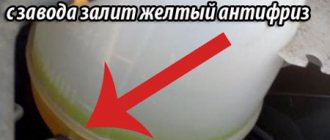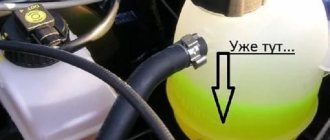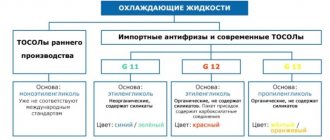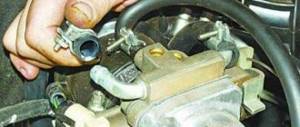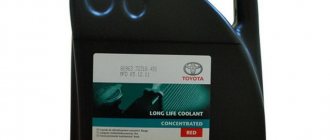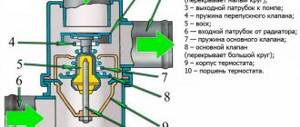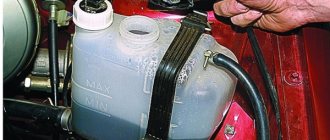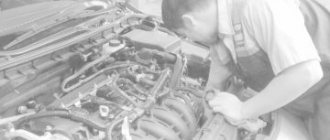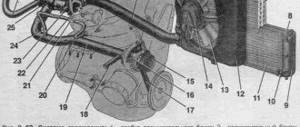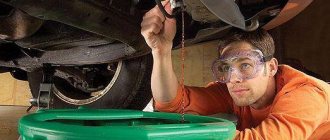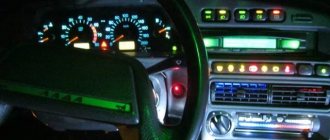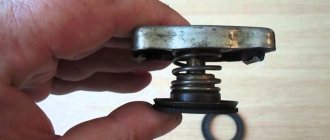Why do you need to breed?
If we go deeper into chemistry, the composition of antifreeze concentrate is nothing more than ethylene glycol (also known as glycol, ethanediol, ethanediol - by the way, that’s what it says on it) - a simple dihydric alcohol, oily consistency, chemical formula - HOCH2CH2OH. It holds the “plus threshold” perfectly, boils only at + 196 degrees, but freezes even at a slightly negative temperature.
ETHYLENE GLYCOL (ETHANEDIOL) – freezes already at minus 13 degrees Celsius , so its pure use is possible only in regions with relatively warm winters!
In its pure form, it practically does not contain any impurities, that is, it is 95 - 99% pure composition - hygroscopic, has a sweetish taste and smell, poisonous - oral use is prohibited (150 - 200 ml can cause severe poisoning and death), mixes well with water, other alcohols and acetones, does not mix well with ethers.
The low minus threshold is its “Achilles heel”; your pure composition will simply freeze at - 13, - 14 degrees Celsius and paralyze the operation of your cooling system! And here it’s not far from the engine overheating.
However, when combined with water, its “lower limit” increases significantly; in fairness, the “upper limit” drops. That is, if diluted with distilled water, you can achieve decent negative readings, often about -40, -60 degrees.
Concentrate
In addition to traditional, ready-to-use coolant, antifreeze concentrate can be found on sale. It differs from conventional antifreeze in the amount of water in its composition.
On the photo of concentrated antifreeze in a car:
They produce concentrated antifreeze because it is convenient to sell this type of product. The buyer can independently dilute the coolant and adjust the lower freezing limit he needs.
Yes, the frost resistance of antifreeze directly depends on the ethylene glycol - water ratio.
To properly dilute the refrigerant, you must use distilled water. It does not contain impurities that will settle inside the pipes, which makes it safe for the cooling system.
Concentrated antifreeze should not be poured into the system, because ethylene glycol in its pure form has less frost resistance. Its freezing threshold is only 11 degrees. At the same time, a liquid of this consistency is very resistant to overheating and boils at a temperature of about +197 degrees. When diluted with water, the boiling point drops to +110 – +120 degrees.
What to breed with?
We simply use ordinary water for this. Although you can use it straight from the tap, I strongly recommend using distilled water. WHY?
Everything is very simple - the water in our apartments contains many foreign substances, these can be salts - magnesium, chlorine or calcium. If you dilute the concentrate with such water, then at positive temperatures, sediment or scale may form (which we can see at the bottom of our teapots). This scale is absolutely unnecessary in the engine cooling system; it can clog small channels or settle on the walls of pipes or radiators, which will impair heat dissipation.
Therefore, it is better to use distilled water, pure H2O, there are no foreign compounds in it, and therefore sedimentation is excluded!
Percentage ratio when diluting liquid with distilled water
If you need to properly dilute antifreeze concentrate, then you should completely read the instructions, which are usually included with the packaging by manufacturers. In no case do not pour more water than necessary, because then the cooler will lose its properties. Don't forget about the climate conditions in which you live.
Antifreeze is a key component along with engine oil, which a car really needs. On the other hand, if you have an electric car, there is no need for a cooler. Without coolant, parts will not last long, so it is worth deciding in advance which coolant concentrate or finished product to use in the future.
How and in what proportion to dilute?
Usually on canisters with concentrates they write how and in what proportion the composition should be diluted. And here it all depends on the temperature threshold of your climate zone. For the middle zone, antifreeze with an indicator of -25 degrees will be sufficient; for more northern zones, at least -40 is needed.
To prepare antifreeze with a temperature of -25 degrees, we need to mix it with water in a 2:3 ratio. Two liters of concentrate and three liters of water. To be fair, it is worth noting that the positive threshold drops from + 196 degrees to approximately + 130, + 140, which is more than enough for most cars.
In order to prepare antifreeze with a value of – 40, – 45 degrees. We need to maintain a 1:1 ratio. That is, water is one component, just like antifreeze. Our upper limit will be approximately + 150, + 160 degrees. This concentration can be used in very cold regions of our country.
I would like to note that you should not dilute the concentrate too much with water, this will also reduce the characteristics of both freezing and “resistance” to high temperatures. So if we add four parts of water to one part of the concentrate, we get only: - 15 degrees (at the lower limit) and about 100 grams. (on the top).
How to dilute antifreeze?
How to dilute antifreeze concentrate? If the product is certified and released onto the market, the packaging will display detailed instructions for proper mixing with distilled water. You need to focus on the climate zone in which you are currently located. If you live in regions where in winter the temperature can easily drop below -20 Celsius, it makes sense to achieve a concentration that will withstand 40-degree frosts.
There are a number of standard values and recommendations:
- In order for antifreeze to withstand temperature drops down to -25 degrees, it is necessary to mix in a ratio of 2 to 3. That is. 2 measuring cups of substrate and 3 cups of distillate. Remember that the boiling point is reduced to 130 degrees Celsius;
- to achieve -45 degrees it is necessary to mix equal parts, i.e. 1 to 1.
This table will show more detailed values.
Pay key attention to the boiling point of the finished liquid . The rule “the more water, the lower the boiling threshold” is fully valid here. Should antifreeze be diluted to critical levels? Act according to the conditions in which the vehicle is being operated. Do not be greedy and overdo it with the “solvent”, otherwise the key product will completely lose its beneficial properties.
Table
| Concentration Water - Concentrate | Freezing threshold | Boiling threshold |
| 87,5% — 12,5% | -7 | 100 |
| 75% — 25% | -15 | 100 |
| 50% — 50% | -40, -45 | +130, + 140 |
| 40% — 60% | -50, -60 | +150, + 160 |
| 25% — 75% | -70 | + 170 |
Breeding rules
For dilution, use distilled water, sold in automotive or hardware stores. Using tap, well or spring water is fraught with trouble. Microelements contained in water quickly settle on the walls of the unit, which leads to a decrease in the cooling effect.
This is interesting: Reviews from Uber drivers
If a manufacturer claims that its products can be diluted with tap water, then a small experiment is conducted to check. Liquid, tap water and solution are poured into a transparent container. The result is checked after two days. If the solution is cloudy or there is sediment at the bottom, then this composition must be diluted with distillate.
If antifreeze is used in heating systems, then its main quality is resistance to boiling over. To prevent the liquid from crossing the vaporization threshold, the antifreeze concentrate must be diluted at a maximum temperature of 95 ° C.
If the proportions are not met, then ethylene glycol will undergo intense evaporation, not water. As a result, the entire coolant will have to be replaced.
In what proportion should water and concentrated liquid be mixed? For example, if you take them one part at a time, the freezing threshold of such a solution is -45 °C, and boiling occurs in the range of 130 - 140 °C.
The table of proportions clearly shows the dilution of antifreeze concentrate.
| Solution concentration, % | Proportion | Crystallization limit, °C | Vaporization limit, °C |
| concentrate – water | |||
| 13 — 87 | -7 | +100 | |
| 25 — 75 | 1:3 | -15 | +100 |
| 50 — 50 | 1:1 | -45 | +135 |
| 60 — 40 | 3:2 | -60 | +155 |
| 75 — 25 | 3:1 | -70 | +170 |
The table displays the manufacturers' requirements for diluting antifreeze concentrate. With increased water content, properties are lost.
Video version
Now there’s a short video of the article, so watch it and I’ll try to clearly explain how to properly dilute antifreeze concentrate.
I’ll finish this, read our AUTOBLOG.
Similar news
- Is it possible to pour water into the engine cooling system? In summer or w...
- Antifreeze composition. In percentage and is it worth doing it yourself?
- Cost of non-freezing liquid. True information
Add a comment Cancel reply
Antifreeze for motorists
There are many manufacturers of coolants, both foreign and domestic. But motorists buy antifreeze according to operational requirements. Widespread brands are G 11 and G 12.
Grade G 11 is green in color and has a service life of 3 years. Brand G 12 is distinguished by its red color. And the absence of silicates in it makes it possible to operate it for up to 7 years. It is worth remembering that they do not mix with each other.
This is interesting: The most stolen cars
List of actions on how to dilute red antifreeze concentrate:
- drain the old fluid from the tank, radiator and cylinder block;
- rinse with distilled water. Water is poured into the system. The engine starts for a short time;
- the water is drained;
- take G 12 concentrate, water and clean containers;
- according to the table, apply a solution suitable for your climate zone;
- the solution is poured into the cooling system;
- After short-term operation, check the level. If necessary, add solution.
